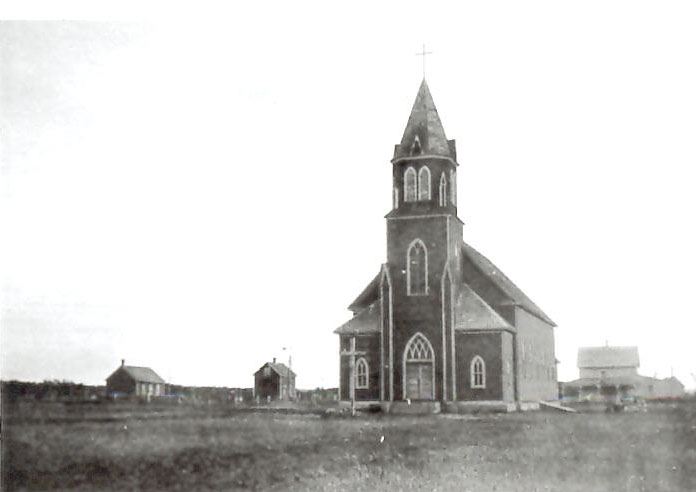This is the 25th in a series of columns about the 70 British Home Children sent to St. Patrick’s Catholic Orphanage in Prince Albert between 1901 and 1907. While all orphanage records were destroyed in the terrible fire of 1947, every attempt has been made to trace the life stories of these dispossessed children through genealogy websites and newspaper databases.
Ethel Jane Kamper: Married a Metis Man
How does a girl born into an impoverished family in the slums of London, England end up marrying into the family of a fighter in the 1885 Metis Resistance at Tourond’s Coulee (Fish Creek), Saskatchewan? Well, first she becomes a British Home Child who gets sent to an orphanage in Prince Albert, Saskatchewan.
Ethel Jane Kamper was born on 7 July 1891 in Lambeth, a district of London in Surrey, England, to Emil Kamper (1855-1908), a Bulgarian waiter, and Margaret (Maggie) Jame Chapman (1860-?). Emil and Maggie must have struggled to care for their four children because by 1901 9-year-old Ethel was living at a Nazareth House in Bexhill, Sussex. The Bexhill establishment housed orphaned and destitute children, mainly Roman Catholic girls. Ethel’s older brother Caleb Fairly Kamper (1886-?) had already been shipped to Canada in 1899 when he was 12 years old.
When she was 11 years old, Ethel embarked from Liverpool aboard the ship Bavaria with 19 other British Home Children all bound for Prince Albert. They left on 15 October 1903 and arrived in Quebec City on 12 October.
What happened to Ethel once the group arrived at St. Patrick’s Catholic Orphanage is not clear. I have not been able to locate her in the 1906 census for the Prairie Provinces. By 1910 or 1911, Ethel was married to Alfred (Fred) Lefort (1879-1946) and living on a farm near Fish Creek, more properly Tourond’s Coulee, in the Humboldt district of Saskatchewan. Fred was a Metis man. Where and how did Ethel meet Fred?
They were both Roman Catholic, so that might be a good starting point in the quest to learn how Ethel, a British Home Child, met Fred, the son on a Metis Resistance fighter. The first church in the RM of Fish Creek – the Immaculate Conception Church – was part of the Métis settlement along the tributary of the South Saskatchewan River. The first members of the Roman Catholic church, built in 1901, were likely all Metis. Father Brueck, who was responsible for St. Patrick’s Catholic Orphanage in Prince Albert was sent to Fish Creek to set up the mission in 1900. (Source: Solange Lavigne, Kaleidoscope. Many Cultures – One Faith. The Roman Catholic Diocease of Prince Albert. 1891 – 1991. 1990). Did Father Brueck or other priests at the PA orphanage maintain ties with the Fish Creek community over the years? Did the orphanage send children like Ethel to the Metis settlement for some reason?

Alfred’s father Boniface Lefort was born on 11 July 1857 in Manitoba’s Red River Settlement, now Winnipeg – the birthplace of the Metis people born from relationships between French voyageurs and Indigenous women. After the 1869 Red River Resistance, the Metis were forced to leave their ancestral lands and find refuge farther west. Boniface Lefort settled his family on a river lot at Fish Creek (Tourond’s Coulee) from 1883 to 1956 (river lot 13-Twp 42A-31-7-W2).
Ethel’s father-in-law Boniface Lefort fought at both Batoche and Fish Creek during the Metis Resistance of 1885. He was a member of Gabriel Dumont’s brother Captain Édouard Dumont’s company. The Battle of Fish Creek (also known as the Battle of Tourond’s Coulée), fought on April 24, 1885, was a major Métis victory over the Canadian forces who were attempting to quell Louis Riel’s North-West Resistance. From their defensive rifle pits in the coulee, Métis marksmen picked off Major General Frederick Middleton’s troops silhouetted on the hilltop. Middleton’s North-West Field Force suffered far more casualties than did the Metis and was delayed in its march on the Metis headquarters at Batoche.
Thirty years later, Ethel and Fred Lefort had started their family of nine children (Laurence, Lauretta, Theodore, Irene, Alphonse, Margaret, Albert, Rita, and Louis) on a farm at Fish Creek. They moved back and forth between Saskatchewan and Manitoba. Census records show the Lefort family living on a farm near Dauphin, Manitoba in 1921 and back at Fish Creek in 1931. Fred died on 16 January 1946 at age 66 from cancer in Brandon, Manitoba and is buried there. I have found evidence that Ethel remarried in 1952 to Hanry Dalle at Roblin, Manitoba but I have not yet been able to verity this. According to a source on geni.com, Ethel died of cancer in January 1965 at Russell, Manitoba. NOTE: This will be one of my last Shattered Lives columns. As you can see above, there are a lot of gaps in my story of Ethel Kamper. I have now written about 44 of the 70 British Home Children at the Prince Albert orphanage but I am having more and more trouble finding information about the remaining 26. My next and final column (in two parts) will tell you what I have learned about these 26 children.


